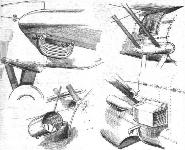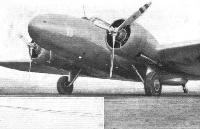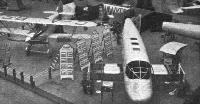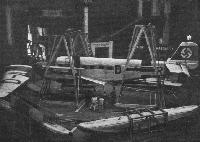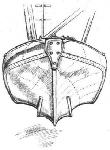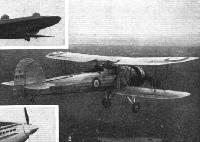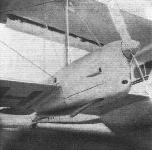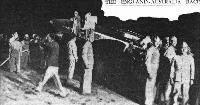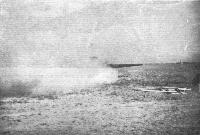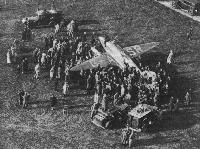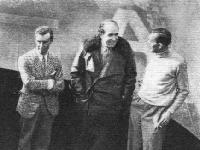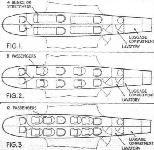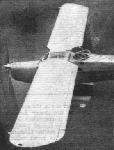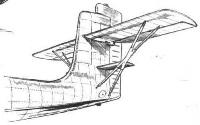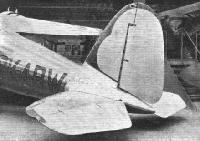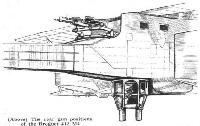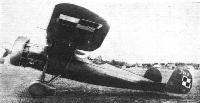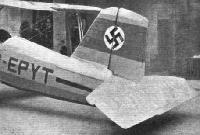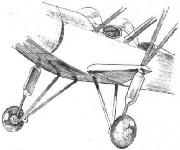Фотографии
-
Регистрационный номер: СССР-Л760 The stand arranged by the Russian Soviet. In the foreground is a full-sized model of the balloon gondola used for stratosphere flights. Behind it is the ancient ski-plane used for the Chelyuskin expedition rescue. On the left is a pair of the huge double wheels of the Maxim Gorky undercarriage, a model of which may be seen above the emblematic hammer and sickle near the foreground.
Самолёты на фотографии: Поликарпов Р-5 - Россия - 1928Туполев АНТ-20 Максим Горький - Россия - 1934
-
Регистрационный номер: SP-PZM The Polish P.Z.L.24, claimed to be one of the fastest Military aircraft in the Show, its Gnome-Rhone K.14 engine giving it a top speed of 257 m.p.h. On the left is the P.Z.L.11C, an earlier version of the 24. Behind them is the P.Z.L.26, specially built for competition in the Challenge de Tourisme.
Самолёты на фотографии: PZL P.11 - Польша - 1931PZL P.24 - Польша - 1933PZL PZL.26 - Польша - 1934
-
Самолёты на фотографии: Potez Potez 54 - Франция - 1933
-
A selection of oil coolers: (top left) Farman 431; (top right) P.Z.L. 24; (bottom left) Focke-Wulfe; (bottom right) Potez 54.
Самолёты на фотографии: Farman F.430 - Франция - 1934Focke-Wulf FW.44 Steiglitz - Германия - 1932Potez Potez 54 - Франция - 1933PZL P.24 - Польша - 1933
-
In the centre of this display is the Breguet 46T as it will look when finished. Two Mistral Major engines of 880 h.p. each are expected to give it a top speed of 240 m.p.h. In the foreground is the Dewoitine D.511, France's latest and fastest fighter.
Самолёты на фотографии: Breguet Br.470 Fulgur - Франция - 1936Dewoitine D.500 / D.510 - Франция - 1932
-
The aileron mass-balances on the Dewoitine 511.
Самолёты на фотографии: Dewoitine D.500 / D.510 - Франция - 1932
-
The radiator underneath the fuselage of all-metal Dewoitine 511 fighter
Самолёты на фотографии: Dewoitine D.500 / D.510 - Франция - 1932
-
"HAWK MAXIMUS": Sqd. Ldr. Malcolm McGregor and Henry Walker reached Melbourne in their standard Miles "Hawk Major" 7 days 15 hours after leaving Mildenhall.
Самолёты на фотографии: Miles Hawk / M.2 - Великобритания - 1932
-
Регистрационный номер: G-ACTD Самолёты на фотографии: Miles Hawk / M.2 - Великобритания - 1932
-
The Letov S.231 has a pair of machine guns in each bottom wing.
Самолёты на фотографии: Letov S-231 / S-331 - Чехословакия - 1933
-
BRISTOL "BULLDOG," MARK IV 600 h.p. "Mercury" V1.S.2
Самолёты на фотографии: Bristol Bulldog - Великобритания - 1927
-
A view from above of the Amiot 142, one of the largest bombing machines in the Show. The engines can either be Hispanos as shown or Gnome-Rhones as in the Amiot 143.
Самолёты на фотографии: Amiot Amiot 140 / Amiot 143BN5 - Франция - 1931
-
Регистрационный номер: K2890 Some Vickers-Supermarine machines: 3, The single-seater day and night fighter (Rolls-Royce "Goshawk").
Самолёты на фотографии: Supermarine Type 224 - Великобритания - 1931
-
This combined Armstrong-Whitworth and A. V. Roe stand is one of the most attractive in the Show. All the three machines are painted white, with their exposed metal surfaces plated.
Самолёты на фотографии: Armstrong Whitworth Scimitar / A.W.16 / A.W.35 - Великобритания - 1931Avro Tutor/Sea Tutor/Prefect / Type 621/646/626 - Великобритания - 1929Cierva/Avro C.30A / Rota - Великобритания - 1932
-
Регистрационный номер: K3574 SHORT "R24/31" Two 700 h.p. Rolls-Royce "Goshawk"
Самолёты на фотографии: Short Knuckleduster / S.18 - Великобритания - 1933
-
An impressive view of the latest Boeing. N.A.C.A. cowlings have replaced the short-chord cowlings fitted to the 247 and three-bladed Hamilton-Standard airscrews are used.
Самолёты на фотографии: Boeing Model 247 - США - 1933
-
Регистрационный номер: NC13361 The new Boeing 247-D has shown a marked improvement in performance on the 247. The engines are geared and supercharged nine-cylinder Pratt and Whitney "H" type "Wasps."
Самолёты на фотографии: Boeing Model 247 - США - 1933
-
The control cabin of the 247-D, showing the mounting of the wireless aerial, the normal screen and the sliding side window.
Самолёты на фотографии: Boeing Model 247 - США - 1933
-
Регистрационный номер: J9186 The Boulton & Paul "Overstrand" with two Bristol "Pegasus" engines.
Самолёты на фотографии: Boulton Paul Overstrand / P.75 - Великобритания - 1933
-
"SKYBIRDS". Three recent additions to the realistic 1-72nd-scale models produced by A. J. Holladay & Co., Ltd. They are: Albatros D.III; D.H. "Comet"; and Fairey "Seal."
Самолёты на фотографии: Albatros D.III - Германия - 1916De Havilland Comet / D.H.88 - Великобритания - 1934Fairey Gordon / Seal - Великобритания - 1931
-
The "Firefly," single-seater fighter (Rolls-Royce "Kestrel")
Самолёты на фотографии: Fairey Firefly - Великобритания - 1925
-
A "PRIVATE VENTURE": The Gloster F.7/30 ("Mercury" VI S.) Day and Night Fighter.
Самолёты на фотографии: Gloster Gladiator - Великобритания - 1934
-
Регистрационный номер: G-ABSE A British corner: the Hawker "Fury" is on the left, and the Bristol 143, interesting for its new form of construction, on the right.
Самолёты на фотографии: Bristol Type 142 Britain First / Type 143 - Великобритания - 1935Hawker Fury - Великобритания - 1931
-
FOREIGN APPRECIATION: One of the Hawker types supplied to foreign air forces. A Portuguese "Fury" ("Kestrel").
Самолёты на фотографии: Hawker Fury - Великобритания - 1931
-
The Bloch 211: One of the very large all-metal military aircraft with revolving gun turrets. In this case the engines are Hispanos.
Самолёты на фотографии: Bloch MB.210 Verdun - Франция - 1934
-
THE OBSERVATORY: The front gunner's enclosed cockpit on this new Marcel Bloch 130 Bomber is similar to that on our Boulton and Paul "Overstrand."
Самолёты на фотографии: Bloch MB.210 Verdun - Франция - 1934
-
OLD AND NEW: A "Rota" flying over the ruins of Old Sarum. The outlines of the old Cathedral appear in the left bottom corner.
Самолёты на фотографии: Cierva/Avro C.30A / Rota - Великобритания - 1932
-
VERSIONS OF THE FAIREY "FOX": The Hispano-engined model, which has a startling performance
Самолёты на фотографии: Fairey Fox - Великобритания - 1925
-
VERSIONS OF THE FAIREY "FOX": The Advanced Training Type, fitted with Siddeley "Serval" engine.
Самолёты на фотографии: Fairey Fox - Великобритания - 1925
-
PHOTOGRAPHY: An airman is handing up a camera to be fitted inside an "Audax"
Самолёты на фотографии: Hawker Audax - Великобритания - 1931
-
THE PUFF TARGET: Practising artillery reconnaissance. The "Audax" is flying low so as to appear in the photograph. Small smoke cartridges are exploded on the ground to represent shell bursts round a target, and the pilot sends down W/T messages to correct the aim.
Самолёты на фотографии: Hawker Audax - Великобритания - 1931
-
Регистрационный номер: K3685 A LINE-UP: Hawker "Audax" machines (Rolls Royce ''Kestrel" engines) of the School of Army Co-operation.
Самолёты на фотографии: Hawker Audax - Великобритания - 1931
-
Регистрационный номер: K4050 FOR THE NEAR EAST: A batch of Hawker "Hardy" general-purpose machines (525 h.p. Rolls-Royce "Kestrel" IB) recently completed by the Gloster Aircraft Co., Ltd. These machines will form the new equipment of No. 30 (B) Squadron, stationed at Mosul, Iraq.
Самолёты на фотографии: Hawker Hardy - Великобритания - 1934
-
The "Seal," Fleet Air Arm three-seater (Siddeley "Panther").
Самолёты на фотографии: Fairey Gordon / Seal - Великобритания - 1931
-
Регистрационный номер: K2681 The prototype Saro Cloud, K2681, used as a navigational trainer and at that time (1934), the only amphibian in service.
Самолёты на фотографии: Saunders-Roe Cloud / A.19 - Великобритания - 1930
-
Регистрационный номер: K3592 A "Singapore III" flying boat (4 "Kestrels") of the type in which Sir Philip Sassoon recently flew from England to Egypt. That boat belongs to No. 210 (F.B.) Squadron at Pembroke Dock.
Самолёты на фотографии: Short Singapore III / S.19 - Великобритания - 1934
-
Самолёты на фотографии: Short Singapore III / S.19 - Великобритания - 1934
-
Регистрационный номер: D-AOAR [2] THE SWASTIKA IN PARIS. A scene in the Grand Palais while preparations were being made for the opening of the Fourteenth International Aero Exhibition, which opens to-morrow. The machine in the foreground is a German Junkers.
Самолёты на фотографии: Junkers Ju.52/3mW (See) - Германия - 1933
-
Регистрационный номер: D-AOAR [2] The Junkers Ju.52 on floats; it has three "Jumo 5" Junkers diesel engines.
Самолёты на фотографии: Junkers Ju.52/3mW (See) - Германия - 1933
-
Head-on view of one of the Junkers Ju.52 floats.
Самолёты на фотографии: Junkers Ju.52/3mW (See) - Германия - 1933
-
Регистрационный номер: K4190 The T.S.R. (Bristol "Pegasus");
Самолёты на фотографии: Fairey Swordfish - Великобритания - 1934
-
The "Vildebeest" ("Pegasus") Torpedo Bomber.
Самолёты на фотографии: Vickers Vildebeest / Type 132 - Великобритания - 1928
-
The "Valentia" (two "Pegasus") Troop-carrier;
Самолёты на фотографии: Vickers Valentia - Великобритания - 1934
-
Регистрационный номер: PH-AJU Самолёты на фотографии: Douglas DC-1 / DC-2 / C-32 / C-39 - США - 1933
-
One of the nacelles, and (right) two of these units mounted on the centre section of the wing.
Самолёты на фотографии: Douglas DC-1 / DC-2 / C-32 / C-39 - США - 1933
-
The split trailing edge flaps, and the arrangement of the retractile undercarriage. Note the generous fillet at the junction of wing and fuselage.
Самолёты на фотографии: Douglas DC-1 / DC-2 / C-32 / C-39 - США - 1933
-
(Top left) The rear portion of the fuselage showing the semi-monocoque construction, (below) a portion of the "multi-cellular" wing, and (right) a part of the cabin structure.
Самолёты на фотографии: Douglas DC-1 / DC-2 / C-32 / C-39 - США - 1933
-
The cockpit of the Heinkel He. 70, the fast German mail-cum-passenger plane for which a top speed of 222 m.p.h. is claimed.
Самолёты на фотографии: Heinkel He-70/Не-170 Blitz - Германия - 1932
-
TUNIS: An aerial view of Tunis Aerodrome. In addition to the French military aeroplanes on the ground, the squadron of Avro 626 aircraft which recently flew out to Egypt from England, are also shown in this picture. Incidentally, these Egyptian machines reached Cairo on October 1.
Самолёты на фотографии: Avro Tutor/Sea Tutor/Prefect / Type 621/646/626 - Великобритания - 1929
-
Регистрационный номер: G-ABPH FOR ECONOMICAL TRAINING: The de Havilland "Tiger Moth" can be fitted with "Gipsy III" or "Gipsy Major" engine.
Самолёты на фотографии: De Havilland Tiger Moth / D.H.82 - Великобритания - 1931
-
FLAPS FOR THE "EXPRESS": The D.H. 86 machines which are being delivered to Jersey Airways next year will be fitted with split flaps on the upper wing.
Самолёты на фотографии: De Havilland Express Air Liner / D.H.86 - Великобритания - 1934
-
A BROAD SMILE: Our old friend Capt. H. S. Broad is pleased with the performance of his 'bus. This happy "snap" was taken when he was testing a D.H. "Dragon."
Самолёты на фотографии: De Havilland Express Air Liner / D.H.86 - Великобритания - 1934
-
The "Hendon" Night Bomber (two Rolls-Royce "Kestrels");
Самолёты на фотографии: Fairey Hendon - Великобритания - 1930
-
Самолёты на фотографии: Percival Gull - Великобритания - 1932
-
A general view of the Salon. In the foreground are corners of the Hawker and Bristol stands, and prominent in the centre of the picture is the Caudron "Aiglon," a two-seater open cockpit development of the Caudron which won the Zenith Cup.
Самолёты на фотографии: Caudron C.600 Aiglon - Франция - 1935
-
Unusual cantilever undercarriage on the Caudron C.600.
Самолёты на фотографии: Caudron C.600 Aiglon - Франция - 1935
-
A development of the "Rafale," the Caudron 520 seats four persons, and with its Renault "Bengali Six" a top speed of 199 m.p.h. is claimed.
Самолёты на фотографии: Caudron C.500 / C.520 / C.620 / C.630 Simoun - Франция - 1934
-
Регистрационный номер: F-ANGH Another French example ot a cheap machine - the little Mauboussin "Corsaire," which is also supplied in a cabin version. The engine may be a Salmson or a Pobjoy.
Самолёты на фотографии: Mauboussin Corsaire / M-120 - Франция - 1932
-
The unusual undercarriage of the Messerschmitt Me 108, which is retractable by means of a worm and worm wheel.
Самолёты на фотографии: Messerschmitt Bf.108 Taifun - Германия - 1934
-
BRITISH KLEMM "SWALLOW" 80 h.p. Pobjoy "Cataract"
Самолёты на фотографии: Klemm L.25 - L.28 Swallow - Германия - 1927
-
A beautiful example of shot-welding on the Russian Stand: the "Stal 2," a four-passenger monoplane built of stainless steel
Самолёты на фотографии: ООС Сталь-2/Сталь-3 - Россия - 1931
-
Some examples of the beautiful workmanship put into the Russian "Stal 2." The whole machine is built up of drawn sections of very thin gauge stainless steel, shot-welded on the Budd system.
Самолёты на фотографии: ООС Сталь-2/Сталь-3 - Россия - 1931
-
Refuelling with Shell at Mersa Matruh in Egypt.
Самолёты на фотографии: De Havilland Dragon / D.H.84 - Великобритания - 1932
-
Регистрационный номер: G-ACRG Самолёты на фотографии: British Klemm BK-1 Eagle - Великобритания - 1934
-
OFF TO THE ANTARCTIC : The Northrop machine. Polar Star, which will be used by the Lincoln Ellsworth Expedition for flights over the South Pole, being shipped at Dunedin en route for Deception Island.
Самолёты на фотографии: Northrop Gamma / A-13 / A-16 - США - 1932
-
Регистрационный номер: G-ACSS, K5084 NOCTURNE: Refuelling the winners' D.H. "Comet" at the Baghdad control. Scott and Campbell Black arrived almost immediately after the Mollisons had left for Karachi.
Самолёты на фотографии: De Havilland Comet / D.H.88 - Великобритания - 1934
-
Регистрационный номер: G-ACSR [4], F-ANPY [4] JUST LIKE A ROCKET: Actually this is Lt. Cathcart Jones and Ken Waller taking off in their D H. "Comet" from Baghdad aerodrome, leaving a trail of sand dust.
Самолёты на фотографии: De Havilland Comet / D.H.88 - Великобритания - 1934
-
Регистрационный номер: G-ACSR [4], F-ANPY [4] HOME AGAIN: The D.H. "Comet" surrounded by an admiring crowd at Lympne alter Lt. Cathcart Jones and Ken Waller had flown 23,000 miles to Melbourne and back in less than a fortnight.
Самолёты на фотографии: De Havilland Comet / D.H.88 - Великобритания - 1934
-
Регистрационный номер: G-ACSR [4], F-ANPY [4] PILOTS AND OWNER: Lt. Cathcart Jones, Ken Waller and Bernard Rubin beside the record-breaking D.H. "Comet" at Lympne.
Самолёты на фотографии: De Havilland Comet / D.H.88 - Великобритания - 1934
-
Регистрационный номер: G-ACSR [4], F-ANPY [4] FOURTH TO FINISH: Lt. Cathcart Jones and Ken Waller in their D.H. "Comet," which finished fourth and is now on its way homeward in an attempt to beat the standing record.
Самолёты на фотографии: De Havilland Comet / D.H.88 - Великобритания - 1934
-
THE ITALIAN HIGH-SPEED FLIGHT: From left to right, Warrant-Officer Fruet, Lt. Buffra, Lt.-Col. Cassinelli, Col. Bernasconi, Commandant of the High-speed Flight, Capt. Baldi, Capt. Scapinelli, and Warrant-Officer (now Lt.) Agello.
Самолёты на фотографии: Macchi MC.72 - Италия - 1931
-
AT DESENZANO: Scene after the successful speed record attempt. The clean design of the Macchi-Castoldi 72.
Самолёты на фотографии: Macchi MC.72 - Италия - 1931
-
AT DESENZANO: Scene after the successful speed record attempt. The machine as it was being brought ashore after the flight. Note the wing surface radiators and oil coolers on the floats.
Самолёты на фотографии: Macchi MC.72 - Италия - 1931
-
The record-breaking Macchi M.72, which is covered almost entirely with radiator surfaces.
Самолёты на фотографии: Macchi MC.72 - Италия - 1931
-
Регистрационный номер: VH-UXY FOR PACIFIC FLIGHT: The twin-engined Airspeed "Envoy" monoplane, in which Mr. C. T. P. Ulm and Mr. G. M. Littlejohn propose to fly from Canada across the Pacific to Australia, being shipped at Southampton for Montreal.
Самолёты на фотографии: Airspeed Envoy / AS.6 - Великобритания - 1934
-
The Mureaux 180 C2, an all-metal two-seater fighter with an unusual cockpit arrangement. The Hispano Xcrs engine has a nose radiator.
Самолёты на фотографии: ANF Mureaux Mureaux 180 - Франция - 1935
-
Регистрационный номер: VH-USB, G-ADUS, X118W AT HAWAII: Sir Charles Kingsford-Smith's Lockheed "Altair," Lady Southern Cross, arrives at Wheeler Field, Hawaii, after its flight from Suva, Fiji.
Самолёты на фотографии: Lockheed Sirius / Altair 8 - США - 1929
-
Регистрационный номер: G-ACKP Самолёты на фотографии: De Havilland Leopard Moth / D.H.85 - Великобритания - 1933
-
Speed without sacrifice of passenger comfort is the chief objective in the design of the H.S.T.10.
Самолёты на фотографии: Blackburn B-9 / HST.10 - Великобритания - 1936
-
Some alternative seating arrangements provided for in the design of the Blackburn H.S.T.10.
Самолёты на фотографии: Blackburn B-9 / HST.10 - Великобритания - 1936
-
Blackburn H.S.T.10 Two Napier "Rapier" VI's
Самолёты на фотографии: Blackburn B-9 / HST.10 - Великобритания - 1936
-
Very English-looking despite its registration letters, the Caudron "Freygate" carries two passengers seated side by side behind the pilot.
Самолёты на фотографии: Caudron C.480 Fregate / C.510 Pelican - Франция - 1934
-
Stainless steel construction: a Hawker "Nimrod" wing.
Самолёты на фотографии: Hawker Nimrod - Великобритания - 1931
-
Регистрационный номер: G-ACUW Самолёты на фотографии: Short Scion / S.16 - Великобритания - 1933
-
Регистрационный номер: D-IBYR SUPER-FLAPPED: A Fieseler (Argus) in the takeoff tests of the International Touring Competition at Warsaw. Note the slots, the huge Fowler flaps extending along the wings, and the small ailerons operating at the tips above the wing surface.
Самолёты на фотографии: Fieseler Fi.97 - Германия - 1934
-
A DETRACTABLE UNDERCARRIAGE: Mr. Mils Burcham, the American aerobatic pilot, looses a wheel from his Bird biplane while stunting at the recent National Air Races, Cleveland. Note the wheel bouncing on the ground. Burcham made a perfect dead-stick landing on one wheel.
Самолёты на фотографии: Brunner-Winkle Bird A / B / C - США - 1928
-
TWENTY-FIVE YEARS AGO: Last Tuesday, October 30, was the twenty-fifth anniversary of Lt. Col. J. T. C. Moore-Brabazon's historic flight at Shellbeach, where, on October 30, 1909, he accomplished a circular flight of one mile on the all-British Short biplane, thereby winning the Daily Mail prize of ?1,000 for the first Briton to fly a circuit of one mile in a British-made machine. Our illustration shows the actual flight in progress.
Самолёты на фотографии: Short Biplane No.2 - Великобритания - 1909
-
COMMANDER AND CRAFT: The Fokker F18, Snipe, which will make the Atlantic crossing next month, and her commander, J. J. Hondong.
Самолёты на фотографии: Fokker F.IX / F.XII / F.XVIII - Нидерланды - 1929
-
Самолёты на фотографии: General Aircraft Monospar ST-4 - ST-12 - Великобритания - 1932
-
The military training version of the cabin Hanriot, in this case called the 190m. The rear cockpit has been arranged to carry a gun-ring
Самолёты на фотографии: Hanriot H.170 / H.180 / H.190 - Франция - 1934
-
The Hanriot 180 T, a small sesquiplane so constructed that the top of the rear portion of its fuselage is interchangeable, thus enabling the machine to be used for a variety of purposes.
Самолёты на фотографии: Hanriot H.170 / H.180 / H.190 - Франция - 1934
-
This is how the special suitcases are arranged in the Hanriot 180 T.
Самолёты на фотографии: Hanriot H.170 / H.180 / H.190 - Франция - 1934
-
The only large flying boat in the Show - the Liore et Olivier H.24-2 with four Gnome-Rhone 7 Kd. 350 h.p. engines. It will be used on the Algiers-Marseilles service.
Самолёты на фотографии: Liore et Olivier LeO H.24 / H.27 - Франция - 1929
-
The tail units and unusual bracing of the Liore et Olivier H.24.
Самолёты на фотографии: Liore et Olivier LeO H.24 / H.27 - Франция - 1929
-
This slot on the P.Z.L.26 smoothes the air flow over the tail at high angles of incidence.
Самолёты на фотографии: PZL PZL.26 - Польша - 1934
-
A NEW REGIME: On October 28 Mussolini celebrated the anniversary of Rome's capitulation to Fascism by, among many other ceremonies, inaugurating the new combine of all the Italian Air Lines into one body called Ala Littoria, which means, in a broad sense, the Fascist Wing. Our photograph, taken at the seaplane port of Ostia, near Rome, shows men painting out the company's old name and painting in the new name in anticipation of the ceremony. The flying boat is a Savoia Marchetti S 66 which runs between Rome and Tripoli.
Самолёты на фотографии: Savoia-Marchetti / SIAI S.66 - Италия - 1931
-
A twin-float seaplane designed for catapult launching: The Pierre Levasseur P.L.200 with Hispano 9 Vbrs engine.
Самолёты на фотографии: Levasseur PL.200 / PL.201 - Франция - 1935
-
One of the floats which support the tail of the Levasseur P.L.200.
Самолёты на фотографии: Levasseur PL.200 / PL.201 - Франция - 1935
-
BRISTOL 120 ("Pegasus").
Самолёты на фотографии: Bristol Bristol 118 / 120 - Великобритания - 1931
-
"Hanging" control column of the Caudron "Phalene"; the cranked column operates the hydraulic brakes.
Самолёты на фотографии: Caudron C.280 / Phalene - Франция - 1932
-
Регистрационный номер: S1648 Some Vickers-Supermarine machines: 1, The "Scapa" flying boat (two Rolls-Royce "Kestrels");
Самолёты на фотографии: Supermarine Scapa - Великобритания - 1932
-
Регистрационный номер: G-ACJJ Самолёты на фотографии: Short Scylla / L.17 - Великобритания - 1934
-
Регистрационный номер: OK-ABW The photograph shows how carefully the fin and tail plane of the Avia 51 are faired into the metal fuselage.
Самолёты на фотографии: Avia Av.51 - Чехословакия - 1933
-
The rear gun positions of the Breguet 413 M4
Самолёты на фотографии: Breguet Br.410 - Франция - 1931
-
ARTISTRY: A Flight photographer's impression of the Caudron C.450 which won the Deutsch de la Meurthe Cup Race this year. It is most effectively displayed at the Paris Aero Show.
Самолёты на фотографии: Caudron C.360 / C.450 / C.460 / C.560 - Франция - 1933
-
A GENERAL PURPOSE TYPE: The Armstrong-Whitworth A.W.19. (725 h.p. Siddeley "Tiger").
Самолёты на фотографии: Armstrong Whitworth A.W.19 - Великобритания - 1934
-
A POLISH TWO-SEATER: The rear gunner in this P.W.S.19 observation monoplane has an exceptionally good field of fire rearwards.
Самолёты на фотографии: PWS PWS-19 - Польша - 1931
-
A CHEAP FRENCH LIGHT PLANE: The Brochet-Poinsard monoplane, which sells at 14,000 francs. Fitted with a 24 h p Poinsard engine (2-cyl., horizontally opposed, air-cooled), it has a speed range of 30-115 km/h (18.6 - 71.5 m.p.h.), and a fuel consumption of 5 litres per 100 km (about 60 miles per gallon).
Самолёты на фотографии: Brochet MB-30 / MB.50 Pipistrelle - Франция - 1934
-
CURIOUSER AND CURIOUSER! This is a new French speed machine designed by M. Payen and constructed at Etampes. Fitted with a 400 h.p. engine it is expected to attain a speed of nearly 400 m.p.h.!
Самолёты на фотографии: Payen Pa.100 - Франция - 1935
-
THE RETRACTILE FASHION SPREADS: A notable feature of the new Bristol Day and Night Fighter, apart from the cantilever low-wing construction, is the use of a retractile undercarriage. The engine is a Bristol "Mercury."
Самолёты на фотографии: Bristol Bristol 133 - Великобритания - 1934
-
Регистрационный номер: D-EPYT The tail units of the Arado 69 - an unusual arrangement obviating the necessity for a split elevator and possibly reducing spinning tendencies.
Самолёты на фотографии: Arado Ar.69 - Германия - 1934
-
The Potez 60, with the three-cylinder 60 h.p. Potez engine, is a French attempt to satisfy the demand for a very cheap and light club machine.
Самолёты на фотографии: Potez Potez 60 - Франция - 1934
-
Streamlined outriggers carrying the undercarriage and wing struts of the little Potez 60.
Самолёты на фотографии: Potez Potez 60 - Франция - 1934
Статьи
- Flight



